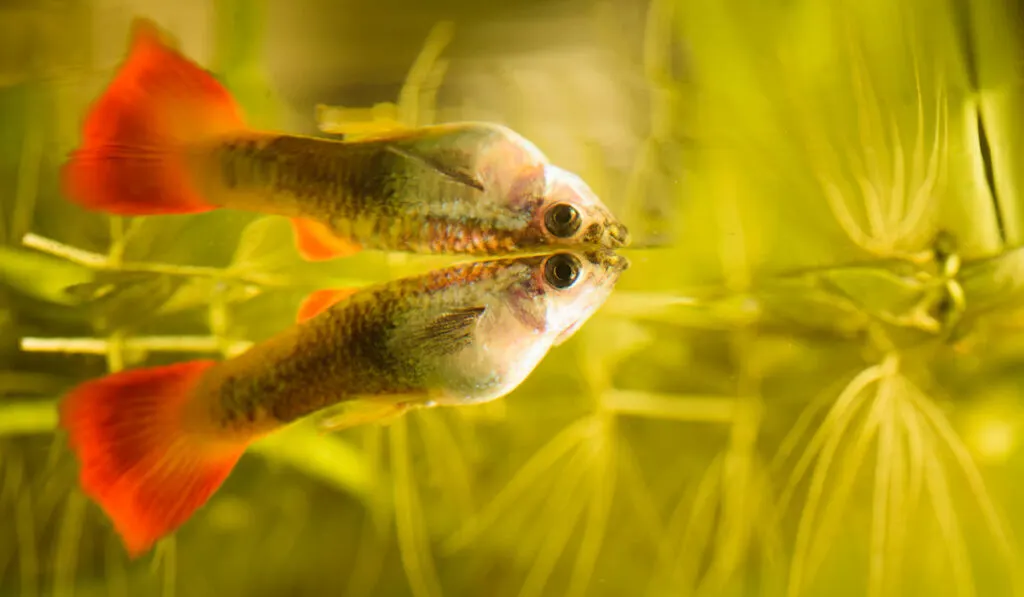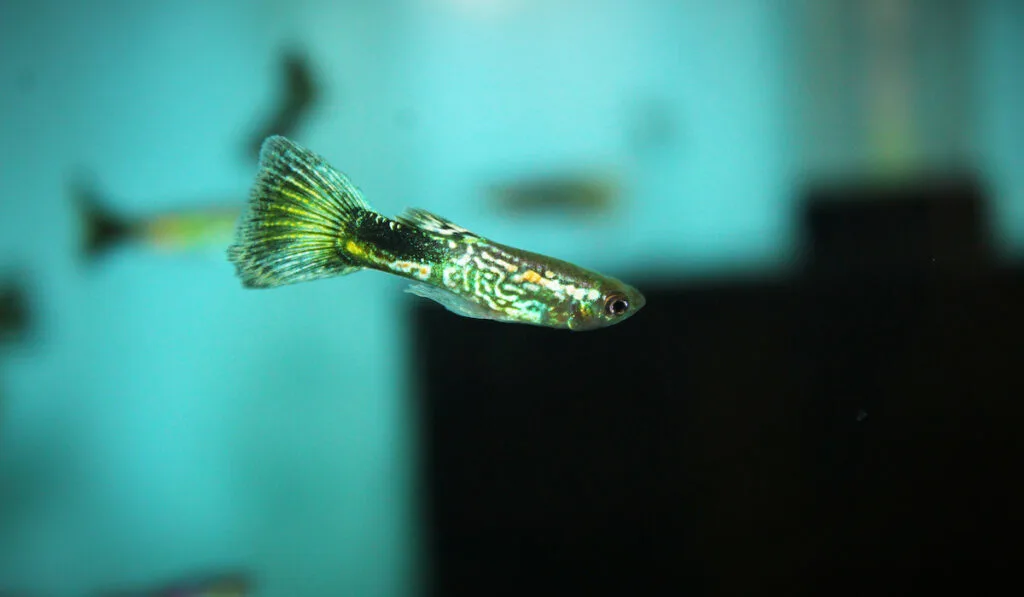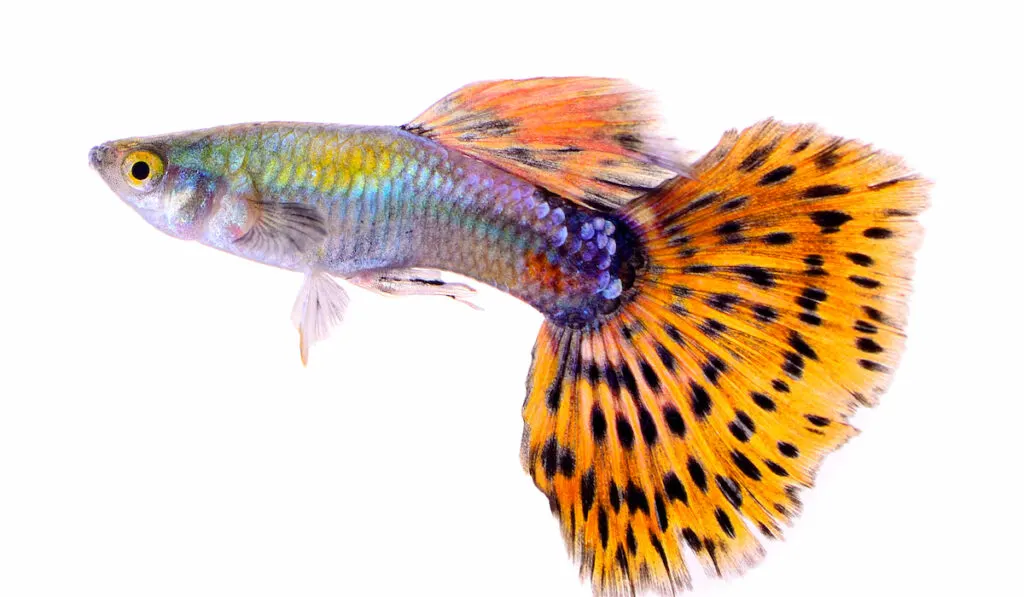Can different colored guppies breed? Guppies of different colors can breed. However, one major factor stands in the way of the success of such breeding – inbreeding. Generally, interbreeding between related guppies (inbreeding) has low success rates. But in the absence of that, different colored guppies should be able to breed successfully.
Generally, all types of guppies can breed together. However, inbreeding between relatives (brothers, cousins, and sisters) is usually unsuccessful.
So, while different colored guppies can breed, you will get the best results if you breed guppies that are not of the same family.

In the rest of this article, we shed more light on the subject matter. But beyond that, we discuss interbreeding between guppies & other types of fish, and much more.
Table of Contents
Can Fancy Guppies Mix With Regular Guppies?
Fancy guppies can mix with regular guppies. However, the fancy guppies may be at a disadvantage in the course of such co-habitation.
Regular guppies typically swim faster than fancy guppies. So, they are more likely to get more food and mate more successfully than the fancy ones. In the end, you may not get many offspring from the male fancy guppies.
What Is the Rarest Guppy Color?
The rarest guppy color is green. This color is pretty hard to develop, hence its rarity. Of course, because green guppies are rare, they are more expensive. Their elevated cost is in line with the high demand for them.
Of the various types of green guppies, the True Green guppy is the hardest to create. The blue and green iridescence must mix in a precise way to get the correct shade or the light will not be reflected at the appropriate angle.
Besides the True Green color, the Half Black Green color is also pretty rare. As the name suggests, a Half Black Green guppy is a green guppy with a dark half.
The half-black of a guppy with such color must have fins in a shimmering green shade.
Can You Breed Different Types of Guppies?
You can breed different types of guppies. However, you should avoid doing this. Interbreeding guppies increases the likelihood of you breeding closely related guppies (inbreeding).
When closely related guppies interbreed, reproduction is usually unsuccessful.
To avoid inbreeding, try to separate closely related guppy strands (brothers, sisters, or cousins) as the population in the tank rises. Alternatively, ensure you only breed guppies of the same species.

How to Breed Different Colored Guppies
If you intend to breed different colored guppies, follow the processes below:
Fish Selection
When selecting the different colored guppies, ensure you keep 1 male to 2 or 3 females. If you have 1 male to 1 female, the male guppy may harass the female. But with 2-3 females, its attention will be split, reducing the chances of harassment.
Next, check out the color patterns of the fishes to be selected. The color pattern of the male guppy should be different from those of the females. You may choose colors based on the output you want.
Some of the primary guppy colors to choose from are blue, blonde, albino, and wild.
The next thing to consider during fish selection is the shape of their tail. There are many options when it comes to tail shape in guppies.
Some of the regular ones include the round tail, the fan tail, and the delta. Others are veil, spear tail, sword tail, and lyre.
All in all, when selecting your guppies, opt for those with bright eyes and colors. Also, ensure their fins are in place.
Tank Selection
When selecting the breeding tank for guppies, ensure you get one with a heater and a tender filter. If the filter is too strong, it may suck up and kill the fries.

If your tank comes with a strong filter, you may cover it with sheer tights.
With the tights in place, the fries will be protected from the force of the filter, and filtration can take place as usual.
Generally, you should opt for a 10- to 20-gallon tank. This should suffice for breeding between 1 male and 2-3 females.
Setting the Tank Up
When setting the tank up, it is vital to provide spots where the fries can hide. Unfortunately, parent guppies sometimes eat their own offspring. But if the fries have places to take cover, most of them will survive.
You may include low-floating plants (such as spawning moss and java moss) in the tank to serve as cover for the fries. Alternatively, you may add a fly trap.
Avoid adding substrates such as rocks to the tank. These substrates make it hard to take note of the number of fires in the tank. They also make it harder to clean the tank.
Water for Guppy Fish
Guppies can tolerate various types of water. But the optimal water for guppies will have the following parameters:
- Temperature – 77 to 79 degrees.
- pH – 6.8 to 7.8.
- Ammonia – 0 ppm.
- Hardness – 8-12 dGH.
- Nitrites – 0 ppm.
- Nitrates – ≤ 10 ppm.
Get High Nutrition Feed
After filling the tank with water at the right temperature, get feed with high nutritional value. A rich diet will promote healthy breeding in guppies.
Place the Guppies in the Tank and Monitor Them

Place the guppies in the tank. Then monitor the females for signs of pregnancy. A pregnant guppy will have a dark mark on its abdomen. This mark is called a gravid spot.
As the pregnancy progresses, the gravid spot will become darker, and during delivery, it is blackest. Typically, gestation in guppies takes 26-31 days. So, estimate the delivery date of your guppies and prepare ahead.
You should be around when the guppies are delivering the fries. Once they are done with labor, get the mothers out. This will keep them from eating the babies.
How Do You Know a Guppy Is in Labor?
When a female guppy goes into labor, you will notice the following:
- It begins shivering because of the contractions.
- It tries to seclude itself.
- It moves closer to the heater.
- It tries staying still.
- Its appetite changes.
Can Guppies Breed With Other Fish?
Fish can either be egg-layers or livebearers.
Livebearer fish develop their eggs in their body and birth them alive. They may also be referred to as ovoviviparous.
On the other hand, egg-layer fish lay their eggs rather than develop them internally.
Now to the question, can guppies breed with other fish? Livebearers cannot procreate with egg-layers. So, since guppies are livebearers, they cannot reproduce with egg-layer fish. Nonetheless, guppies can breed with some other livebearer fish. Such fish include Endler’s Livebearer and mollies.
Final Thoughts
Different colored guppies can breed. However, to ensure the reproduction process is successful, only breed guppies that are not related.
Guppies cannot breed with egg-layer fish. But they may do so with specific livebearer fish. So, take note of this when trying to crossbreed your guppies.
Resources
- https://drguppy.com/can-different-types-of-guppies-breed/
- https://fishtanksetups.com/can-different-types-of-guppies-breed/
- https://www.fishlore.com/aquariumfishforum/threads/guppy-breeding-and-mixing-wild-with-fancy.147297
- https://fishtanksetups.com/rare-guppy-breeds/
- https://www.wikihow.com/Breed-Guppies
- https://www.buildyouraquarium.com/breeding-guppies/
- https://guppyexpert.com/guppy-fish-care/
- https://aquariapassion.com/guppy-molly-hybrid/
- https://www.fishforums.net/threads/what-livebearers-can-crossbreed.275622
